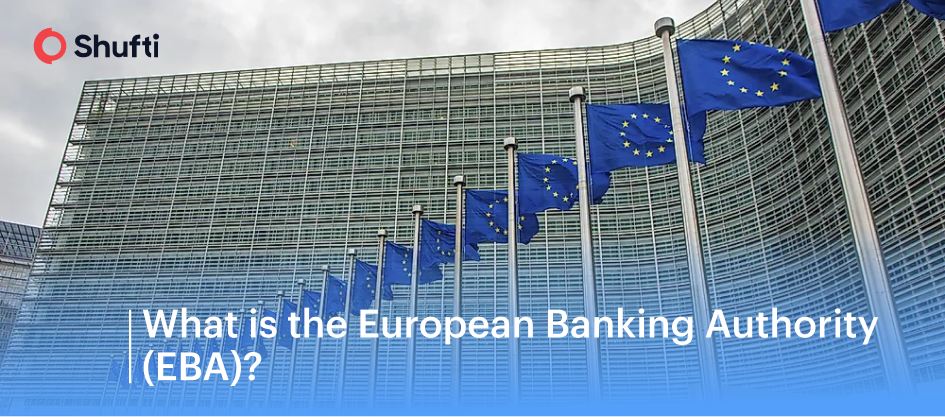What is the European Banking Authority (EBA)?

- 01 What are the duties of the European Banking Authority?
- 02 Who Must Comply With the EBA’s Framework?
- 03 How Does the European Banking Authority Function?
- 04 What Are the Core Areas of the EBA’s Work?
- 05 How Does the EBA Enforce Compliance?
- 06 What Are the Latest Developments in EBA Regulation?
- 07 What Challenges Does the EBA Face?
- 08 Final Thoughts
From financial connectivity to policy-making European Union remains the most integrated region in the world, and the European Banking Authority (EBA) plays a vital role in the integration of financial policies. The EBA sets rules to ensure that banks across the European Union manage risks responsibly, follow unified regulations, and maintain resilience amid financial crises.
EBA was created in 2011 after the global financial crisis of 2008 to ensure that banks across Europe operate under a consistent set of regulations. By harmonizing rules, supervising risk management, and promoting transparency, the authority safeguards not just financial institutions but also citizens, investors, and governments that depend on a stable banking system.
The Banking Authority operates as an independent agency of the European Union within the European System of Financial Supervision (ESFS), alongside the European Systemic Risk Board (ESRB), the European Securities and Markets Authority (ESMA), and the European Insurance and Occupational Pensions Authority (EIOPA). The headquarters of EBA is in Paris, France.
What are the duties of the European Banking Authority?
The EBA aims to strengthen the European financial system by creating uniform supervisory standards and ensuring that national regulators apply them consistently.
EBA’s core objectives include:
- Protecting financial stability through the prevention of regulatory loopholes exploitation and reducing the risk of bank failures.
- The creation of a level playing field whereby banks in all the EU countries are subjected to the same prudential regulations.
- Safeguarding depositors and consumers by means of transparency, responsible banking, and early detection of systemic risks.
- Facilitating the cooperation of national supervisors in order to regulate cross-border banking groups.
- Ensuring confidence in the banking system in Europe by stress testing, risk assessment, and reporting of credible financial information.
In simpler terms, the EBA acts as the guardian of the banking integrity of the European Union Countries. It builds the foundation that keeps Europe’s financial system safe, fair, and future-ready.
Who Must Comply With the EBA’s Framework?
The EBA does not directly supervise individual banks itself, but issues guidelines for the institutions that oversee individual banks. Depending on the country, these may be National Competent Authorities (NCAs) or independent financial regulators. The EBA work is applicable to a broader scope of banking and financial institutions, including:
- The Capital Requirements Directive (CRD) and Capital Requirements Regulation (CRR) are applicable to credit institutions and banks.
- Investment companies that retain client funds or engage in risk-based activities.
- Payment and e-money institutions governed by PSD2 and EMD.
- Deposit guarantee schemes to ensure customer deposits are protected.
- Crypto-asset issuers under the Markets in Crypto-Assets (MiCA) framework, particularly those offering asset-referenced or e-money tokens.
- Mortgage Credit Providers.
In this framework, the power of the authority spreads through the entire levels of the financial ecosystem, i.e., large multinational financial institutions to fintech companies entering the European digital market.
How Does the European Banking Authority Function?
The EBA performs its role through a carefully designed legal framework that combines regulation, supervision, and coordination. EBA aims to create a single market for Europe’s banking sector.
1. Developing the Single Rulebook
The Single Rulebook is the foundation of EU banking regulation. It makes sure that all the financial institutions within the Union are subject to the same prudential standards. The EBA drafts Technical Standards (TSs), including Regulatory Technical Standards (RTS) and Implementing Technical Standards (ITS), which are subsequently adopted if endorsed by the European Commission and are directly enforceable law.
2. Issuing Guidelines and Recommendations
The EBA offers guidelines and recommendations in places where detailed legislative rules are not feasible. These principles facilitate harmonisation of the national regulators and a ‘comply or explain’ response, meaning national regulators are obliged to adopt or explain the reasons why they do not.
3. Conducting EU-Wide Stress Tests
In order to be resilient, the EBA conducts stress tests of key European banks biennial basis (every two years), with scheduled adjustments in exceptional years. These simulations determine the performance of institutions during a hypothetical severe economic shock. The results are also reported publicly, giving investors, depositors, and policymakers insights to judge the strength of the system.
4. Monitoring and Mediation
The EBA also resolves the conflict cases among the national regulators, examines the violations of EU law, and can make binding resolutions to remedy non-compliance. It can also respond in financial emergencies to facilitate supervisory responses across the European borders.
5. Promoting Consumer and Market Integrity
By using its Consumer Protection and Financial Innovation mandate, the EBA creates rules regulating product oversight, responsible lending, and transparency. It is also in charge of the EBA Q&A platform on which the national authorities and banks may seek clarifications on technical matters on the EU banking law.
What Are the Core Areas of the EBA’s Work?
The EBA’s work can be grouped into five main areas:
Prudential Regulation
Defining capital, liquidity, and leverage requirements to ensure banks can afford losses and remain solvent during crises.
Recovery and Resolution
EBA supports the recovery and resolution by issuing guidance to the Single Resolution Board (SRB). The board is responsible for resolution planning and execution strategy aimed at cooperating, without destabilizing, the wider economy or burdening taxpayers.
Payment Services and Open Banking
Setting the rules for strong customer authentication (SCA), open banking, and secure payment infrastructure under PSD2.
Anti-Money Laundering (AML)
The EBA aligns the AML/CFT principles and oversees the effectiveness of supervision in the EU. However, after the creation of the Anti-Money Laundering Authority (AMLA), this role is being transferred to AMLA gradually. The AMLA began operations in July 2025 and is expected to start direct supervision in 2028.
Innovation and MiCA
Under MiCA (Markets in Crypto Assets), the EBA is responsible for regulating significant asset-referenced tokens (ARTs) and e-money tokens (EMTs). It sets standards for governance, reserve management of reserves, and consumer protection for crypto issuers.
How Does the EBA Enforce Compliance?
The strength of the EBA is through standard-setting, coordination, and enforcement by use of legal means instead of direct policing.
It can:
- Examine possible violations of the EU law through national supervisors.
- Make binding decisions to enforce compliance with the EU banking rules.
- Arbitrate conflicts among the supervisory authorities of various member states.
- Organize emergency responses in case of a financial crisis.
Non-compliance with EBA standards can result in enforcement actions by national regulators or escalation to the European Commission, guaranteeing accountability across the system.
What Are the Latest Developments in EBA Regulation?
Transition to the Anti-Money Laundering Authority (AMLA)
The EU’s new AMLA, based in Frankfurt, will assume full AML supervision powers by the end of 2028. The EBA is in the process of transitioning and is setting guidelines and data structures.
Sustainable Finance and Climate Risk
The EBA is incorporating Environmental, Social, and Governance factors into prudential regulations. Its climate risk stress testing regulations assist banks in evaluating their exposure to carbon-intensive sectors and modify portfolios accordingly..
Digital Operational Resilience
The Digital Operational Resilience Act (DORA) expands the EBA’s role in overseeing IT risk and cybersecurity for banks, cloud providers, and third-party service vendors.
Crypto-Assets and Fintech Integration
The EBA supervises significant crypto issuers under MiCA, setting governance and reserve requirements. It also works with ESMA as well as the ECB (European Central Bank) to incorporate crypto regulation into the wider financial stability framework in Europe.
Transparency and Consumer Protection
EBA is also enhancing the product oversight and governance (POG) guidelines to prevent deceptive marketing, greenwashing, and unfair practices in the retail banking sector.
What Challenges Does the EBA Face?
Despite its success in harmonizing EU banking rules, the EBA faces persistent challenges:
- Scattered national implementation that delays convergence.
- Finding a balance between regulation and innovation as fintech continues to transform finance.
- Resource constraints amid expanding responsibilities in ESG, digital, and crypto sectors.
- Legal complexity when aligning EBA guidelines with changing EU legislation.
Overcoming these hurdles is crucial in order to maintain a secure and competitive European banking ecosystem.
Final Thoughts
The European Banking Authority EBA is the pillar of the EU financial infrastructure. Through harmonisation, coordination of supervisors, and the strengthening of the financial sector, it ensures that banks in Europe work in a safe and transparent manner.
The modern financial environment is changing at a dramatic pace because of digitalization and global connectivity. Compliance with the frameworks of EBA is not only a requirement but also a strategic need of the organization that wants to gain trust and build a stable foundation in the long term.



